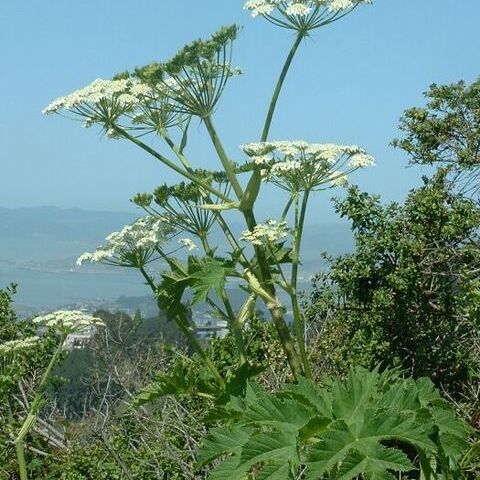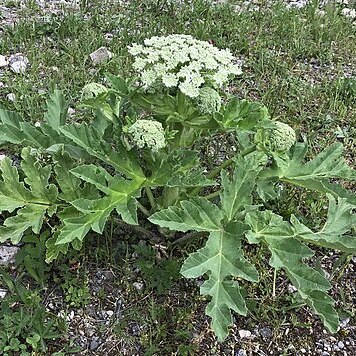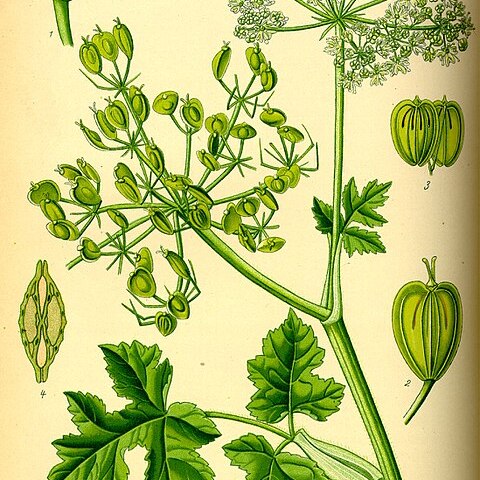Perennial or biennial herbs, dwarf to gigantic, glabrous or more frequently ± densely furnished with unicellular, simple and subglandular hairs. Leaves simple and lobed to 1–2-pinnately or ternately divided with usually broad, dentate-incised to pinnatifid segments; sheaths often large, soft. Umbels numerous, compound, pedunculate; involucre present or absent; involucel usually of numerous narrow bracteoles. Flowers polygamous. Calyx-teeth present, small and usually deciduous. Petals white to creamy, greenish or pink, the outer petals of the outer partial umbels slightly to very conspicuously radiate, the inner with an inflexed tip. Fruit very strongly dorsally compressed with thickened marginal wings and 3 filiform but often quite prominent dorsal ribs, glabrous to hairy; stylopodia conical, from a broad crenate-margined discoid base; vittae solitary in the valleculae, 0–2 on the commissure, slender to clavate, usually reaching most of the way down each mericarp but sometimes short; carpophore deeply bifid. Endosperm very flattened, shallowly rounded dorsally or sulcate at the vittae, flat or slightly concave centrally on the commissural face.
Fr elliptic to obovate, strongly flattened dorsally, usually pubescent, the lateral ribs broadly winged, the others filiform; oil-tubes 2–4 on the commissure, solitary in the intervals, extending only part-way from the stylopodium toward the base of the fr, readily visible; carpophore bifid to the base; umbels large and compound, with numerous unequal rays; bracts lanceolate, deciduous; umbellets many-fld; bractlets linear; sep minute or none; pet white; outer fls of at least the marginal umbellets irregular, the outer pet enlarged and often bifid; tall, stout biennials and perennials with large, ternate or once pinnate lvs and broad, toothed or cleft lfls, the petioles sheathing and usually conspicuously expanded. 60, circumboreal, only one native to N. Amer.
Perennial or biennial herbs, seldom glabrous. Leaves broad-lobate to tripinnate, rarely ternately dissected, segments broad. Umbels compound with many rays. Involucres few or 0, simple, rarely many; involucels many, rarely divided. Flowers polygamous, often radiating, white or yellowish. Calyx teeth obsolete, seldom small, linear, lanceolate. Petals obovate, cuneate-rhomboid or unguiculate, emarginate to 2-fid with inflexed tips. Ovary hairy or pubescent. Fruits orbicular-obovate or elliptical, strongly dorsally flattened; dorsal and intermediate ribs thin-filiformous, lateral ribs usually with a broad wing; vittae usually solitary in each ridge, as long as the mericarps or abbreviated and dilatated below. Carpophore 2-partite.
Biennial or perennial herbs, usually hairy and often rhizomatous, sometimes of great size. Lvs 1-3-pinnate or ternate, or simple and digitately lobed; segments usually broad. Umbels compound, pedunculate; bracts and bracteoles present or 0, entire. Petals white, greenish or pink, usually irregular; petals of inner fls entire and inflexed, those of outer fls often 2-lobed; calyx teeth minute. Fr. ellipsoid to globose, strongly flattened dorsally, not beaked, spineless, but sometimes hairy; commissure broad; ribs 5 per mericarp, the dorsal slender, the lateral with a thickened wing; lateral wings of opposing mericarps appressed; vittae broad, club-shaped, solitary in furrows and < fr.
Petals white (sometimes flushed with pink, especially in bud), often markedly unequal and radiate, those on the outer margin of the umbel being much larger than those on the inside, the whole umbel therefore tending to function like a capitulum in attracting insects, although the individual flowers remain quite distinct.
Vittae solitary in the intervals, clearly visible from the exterior, and tending to be club-shaped, narrowing towards the base, with 2 in the commissural face.
Marginal ridges expanded to form a broad wing, the dorsal ones filiform; wings somewhat thickened and closely appressed to those of the opposing mericarp.
Fruit orbicular to broadly obovate, very strongly dorsally compressed, with a broad commissure.
Leaves pinnately divided, usually with broad segments.
Umbels compound; bracts 0; bracteoles several.
Calyx teeth minute or obsolete, unequal.
Perennial, biennial or annual herbs.



